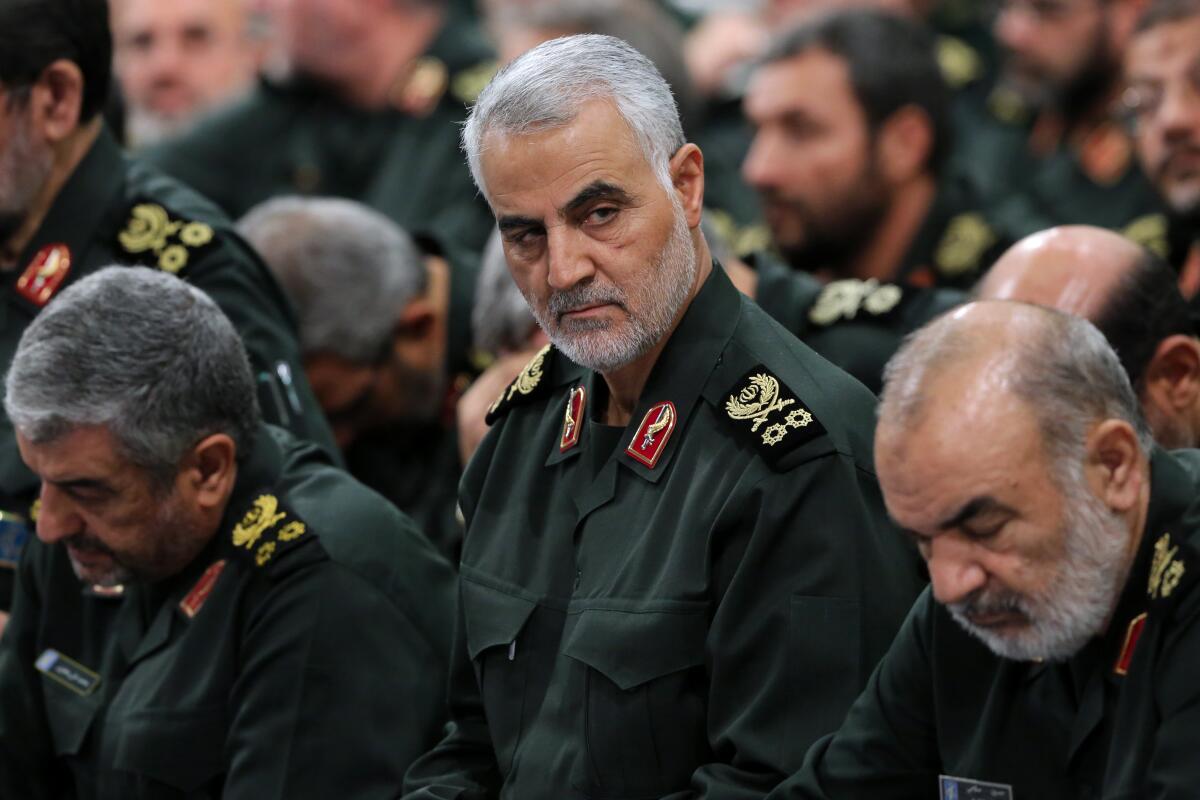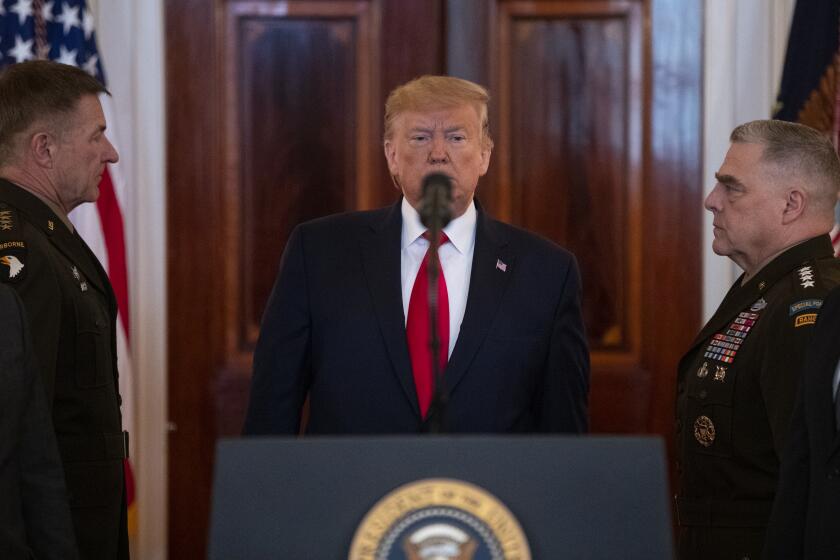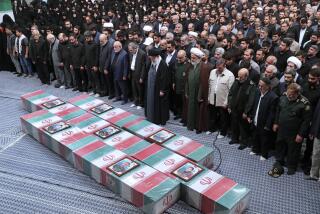The general is dead. The missiles have flown. What next?

When faced with foreign threats, the Islamic Republic has long been calculating and strategic. But before Tuesday night, the Islamic Republic’s de facto move had been to operate with a degree of plausible deniability, choosing militant proxies in places such as Iraq to disrupt U.S. interests while advancing its flair for regional mischief.
Its decision to launch 15 ballistic missiles at two military bases used by U.S. forces in Iraq, however, signaled a shift in strategy — if only temporary — to confront the U.S. directly.As swift retaliation for the U.S. killing of Gen. Qassem Suleimani, the missile strikes were designed to appease an angry Iranian population. But the gambit was calibrated so as not to further draw the ire of President Trump, who along with Iranian leaders appeared to ease tensions on Wednesday.
Both sides claimed victory. Yet the larger, more menacing dilemma is what Iran’s next maneuver will be in its decades-long struggle with America. Tehran is skilled at asymmetrical warfare, cyberattacks and bold strikes, such as last year’s drone assault on a Saudi Arabian oil refinery that rattled world markets. Iran also has third-party forces, most notably the Lebanon-based militant group Hezbollah, that can be called on to create conflicts across the Middle East, including in Israel, Iraq, Syria and Sunni Arab gulf states.
In Trump, the Iranians are confronting an unrestrained and unpredictable leader with little patience for the diplomacy practiced by his predecessor, Barack Obama. Trump walked away from Obama’s deal to limit Iran’s nuclear capabilities; he prefers the immediate gratification of a volley of threatening tweets to the intricacies of negotiating accords. His brash personality, his targeting of Suleimani and his administration’s ill-defined foreign policy have forced Iran to reexamine its strategy.
Iran’s missile attack was an escalation, yet it was a well-calibrated move that showed restraint. By choosing to attack U.S. forces in Iraq without causing any American casualties, the Islamic Republic was aiming to demonstrate a proportionate response to the international community while signaling unity and resolve to its domestic audience, experts said.
Iran’s missile strike caused no casualties and did little significant damage. Was that Tehran’s intent, or just a lucky accident?
“This shooting of missiles and trying to make sure no Iraqi and American lives were lost, in that sense they can have a narrative of success,” said Ray Takeyh, a senior fellow for Middle East studies at the Council on Foreign Relations. “They said ‘look, we did respond, we did not sit still.’”
But at the time same, some analysts said Iran might have inched itself closer to further direct military conflict with the U.S. The tense mood in Tehran on Wednesday reflected those concerns, with some people fearing the U.S. would retaliate, according to Tehran-based journalist Mahyar Zahed.
“The situation was fraught with anxiety and concern over the start of war and at the same time a happy part of society for revenge on Suleiamani’s murder,” he said.
The day before, hundreds of thousands of Iranians flooded the streets of Tehran to mourn Suleimani’s death. “Iranians don’t want war. Those that came to mourn Suleimani did it [out] of a sense of patriotism,” said Zahed. “Some came to love Suleimani’s charismatic personality.”
So far, authorities in Iran have been using the missile strikes to their advantage, creating a narrative of success that suggests the attack is “just the beginning.” For instance, Iranian Supreme Leader Ayatollah Ali Khamenei on Wednesday said the assault on U.S. forces at Iraqi bases was “a slap in the face of the United States,” adding that “this region won’t accept the U.S. presence.”
Maj. Gen. Mohammad Bagheri, the Iranian armed forces’ chief of staff, said “the U.S. should take last night’s attack as a warning and only as a small part of the Iranian forces’ capabilities,” the semiofficial Tasnim News Agency reported.
The missile barrage, coupled with the brazen threats, serves as a message to the Trump administration that Iran will not waver and plans to continue its regional activity, according to Ehsan Ejazi, a Tehran-based researcher at the Center for Scientific Research and Middle East Strategic Studies. Still, Ejazi said, officials recognize that any further direct military contact will not bode well for the future of the Islamic Republic.
“It is not in the interest of the Iranian government to escalate,” he said, “because it knows every war may lead to the destruction of Iran.”
Much of what happens next depends on developments in the next 48 hours. Days ago, Trump said he would order an attack if Iran struck U.S. bases. But on Wednesday, Trump appeared to back away from any further military action, instead calling for more economic sanctions on Iran.
Iranians listened closely to Trump’s remarks Wednesday, said Zahed, the Tehran-based journalist. “After Trump’s speech,” he said, “the Iranian atmosphere seems to have been somewhat relaxed.”
Given that Iran has demonstrated significant precision with its ballistic missile capability in the past, the fact that there were no casualties and that hangars and other equipment were hit at the two bases in Iraq suggests it was a symbolic move aimed at demonstrating strength.
Adding to that impression was a statement by Iran’s foreign minister, Mohammad Javad Zarif. In a tweet after the missile strikes, Zarif suggested the action could be the end of escalation and retaliation for Suleimani’s death.
“Iran took & concluded proportionate measures in self-defense under Article 51 of UN Charter targeting [the] base from which cowardly armed attack against our citizens & senior officials were launched,” he said. “We do not seek escalation or war, but will defend ourselves against any aggression,” he wrote.
Rachel E. VanLandingham, a retired Air Force Judge Advocate General Corps officer, said this gave both the U.S. and Iran a “de-escalatory off-ramp from greater hostilities.”
Still, experts are divided on whether Iran’s attack will be its last. That could largely depend on Trump’s next moves. Dalia Dassa Kaye, director of the Center for Middle East Public Policy at the Rand Corp., said the stark difference in Iran’s response — namely that it used missiles from Iranian territory and publicly acknowledged the attack — means this is a new reality.
“It becomes much harder to calm things down when we are now in an open and direct conflict with Iran,” she said.
The ballistic missile launches targeting two military bases, including the sprawling Asad Air Base in western Iraq, was the first direct Iranian military attack on American forces since Trump withdrew from the 2015 landmark nuclear deal and reimposed tough economic sanctions, underscoring a significant escalation in already simmering U.S.-Iranian tensions.
In the past, Iran’s aggression had been limited to proxy military engagements and threats that it would develop its nuclear program. In proxy engagements under Suleimani’s leadership, Iraqi Shiite militants killed more than 500 U.S. service members in Iraq between 2005 and 2011, according to documents declassified by U.S. Central Command in 2015. And Iran recently escalated its threats about its nuclear program, saying that, in light of Suleimani’s killing, it would no longer abide by the most important limits in the nuclear accord, even though Tehran was not walking away from the deal completely.
Some U.S. politicians are worried.
Sen. Chris Coons (D-Del.) said he was skeptical that Iran was finished with its retaliation.
“I am hopeful that the Iranians will recognize that de-escalation is the wisest course for all parties,” he said. “But given Iran’s long — decades long — history of aggressive action toward the United States, both overt and covert, I am concerned that we not let our guard down.”
U.S.-Iran tensions have been rising for some time. The immediate chain of events that led to Iran’s retaliation began in late December when missile fire on an Iraqi military base killed an American contractor from Sacramento. The U.S. blamed Iranian-backed militia groups and responded with an airstrike that killed 25 people.
A dangerous tit-for-tat ensued, eventually culminating in the U.S. airstrike last week that killed Suleimani.
For now, it remains difficult to gauge whether Iran or the U.S. will come out on top. Suleimani’s death has resulted in fierce anti-American backlash in Iran and across the Middle East. But if Iran’s proxy-building capability has been damaged, then in the long run the U.S. has undermined a significant pillar of the Islamic Republic’s foreign policy.
More to Read
Start your day right
Sign up for Essential California for news, features and recommendations from the L.A. Times and beyond in your inbox six days a week.
You may occasionally receive promotional content from the Los Angeles Times.











